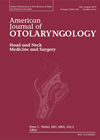You searched for "assistive"
Dutch pharyngeal pouch surgery experience
A decade’s experience of pharyngeal pouch surgery was reported in this paper from Rotterdam. A total of 94 patients were analysed. The majority (80%) underwent an endoscopic approach, either with stapling or CO2 laser-assisted. Interestingly, 13 of 75 (14%) procedures...CAD/CAM assisted mandibular reconstruction or freestyle?
1 September 2016
| Sunil K Bhatia
|
Computer-aided design, Computer-aided manufacturing, Mandible, Microsurgery, Morphological results, Reconstructive algorithm
The gold standard for the reconstruction of the mandible is a free bone flap and the fibula is commonly used. The fibula is a straight bone and presents considerations and difficulties in the formation of a U-shaped neo-mandible. Computer aided...
CT guided cochlear implant programming improves performance
1 July 2016
| Anand Kasbekar
There is currently no national (UK) consensus on imaging patients for cochlear implantation. This paper may change that. It has shown increased hearing and quality of life in paediatric cochlear implant (CI) users when the programming has been assisted by...
Who finds it hard to swallow?
1 October 2018
| Roganie Govender
|
ENTA - Laryngology / Swallowing / Voice
|
Accuracy, Deglutition, Deglutition disorders, Dysphagia, Screening, Sensitivity, Stroke, Swallowing
Early identification of dysphagia in inpatients on acute stroke wards has been recommended as best practice guidelines in many countries. However, several institutions fail to use formal dysphagia screening protocols and rely on informal detection by nurses and doctors. This...
Consider PCR testing in culture negative necrotising otitis externa
1 May 2015
| Anand Kasbekar
Necrotising otitis externa (NOE) often does not yield identification of a causative organism to treat although in 90% of cases it is a member of the pseudomonas species. The incidence of fungal NOE is not to be forgotten and this...
The UK otolaryngology trainees’ lived experience during the COVID-19 pandemic
17 February 2022
| Jessica Ball, Fenella Shelton, Summy Bola, Manish George
|
ENTA - Covid-19, ENTA - Laryngology / Swallowing / Voice
Much has been published on the concerns and real impact of the pandemic on surgical training. In this article, colleagues from the Association of Otorhinolaryngologists in Training (AOT) in the UK share the experiences of their membership. We invite our...
Is a hemithyroidectomy as effective as a total thyroidectomy for compressive symptoms?
10 March 2023
|
ENTA - Thyroid / Parathyroid Surgery
|
Dysphagia, Dyspnea, Goiter, Hemithyroidectomy, Thyroidectomy
The claim made in the title of this paper, that hemithyroidectomy is equally as successful as total thyroidectomy in alleviating compressive symptoms from goitres, is certainly intriguing. And with the inclusion of 45,539 subjects, it would at first glance seem...
The benefits of early voice therapy for unilateral vocal cord paralysis
This retrospective review of voice outcomes following a diagnosis of unilateral vocal fold paralysis divided patients into three groups according to the time of initiation of voice therapy following the onset of paralysis. The ‘early’ group started voice therapy within...How patients reacted to postponement of cochlear implant surgery due to COVID-19
2 March 2022
| Madhup K Chaurasia
|
Otology, COVID-19
|
Cochlear Implantation, Communication, Covid-19, Pandemics, Psychology, Qualitative Research, Quality Of Life
The onset of COVID-19 in 2020 required widespread cancellation of elective surgeries, one of these being cochlear implant for profoundly deafened adults and post-lingually deafened children. Through a questionnaire, to which 23 out of 38 patients responded, this qualitative study...
Teleaudiology Today: Remote Assessment and Management of Hearing Loss
4 July 2024
| Darren Cordon
|
ENTA - Audiology - Adult
The Covid crisis saw many audiology services, private and public, scramble to find other methods of continuing to deliver services to new and existing patients/clients. This textbook builds on international research that the authors published during that time and the...
Paediatrics Issue I
To skip directly to features, click the links below: Welcome from the editor - by Prof Ray Clarke and Claire Benton Industry News Setting up a paediatric ORL service with limited resources - by Raman Eswaran Engaging adolescents in hearing...Post-total laryngectomy constipation
3 November 2022
| Gauri Mankekar
|
ENTA - Head & Neck
|
Chronic constipation, Cross-sectional study, Free jejunal, Total laryngectomy, Total laryngopharyngectomy
This cross-sectional study investigated the prevalence of chronic constipation post total laryngectomy (TL) and after total pharyngolaryngectomy (TPL). For the study, the authors used a self-completed patient questionnaire to evaluate the prevalence and factors related to it. Patients using opioids,...













